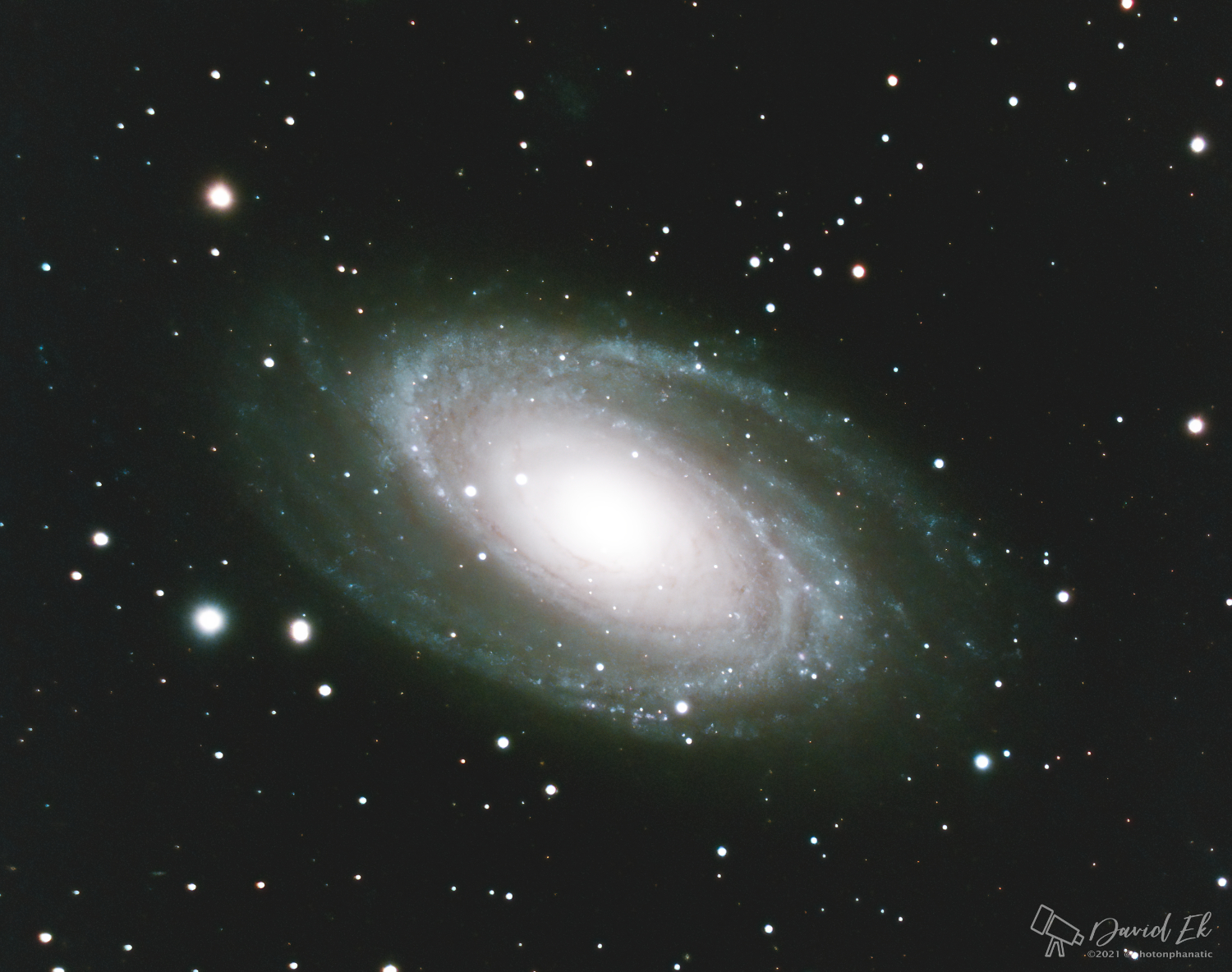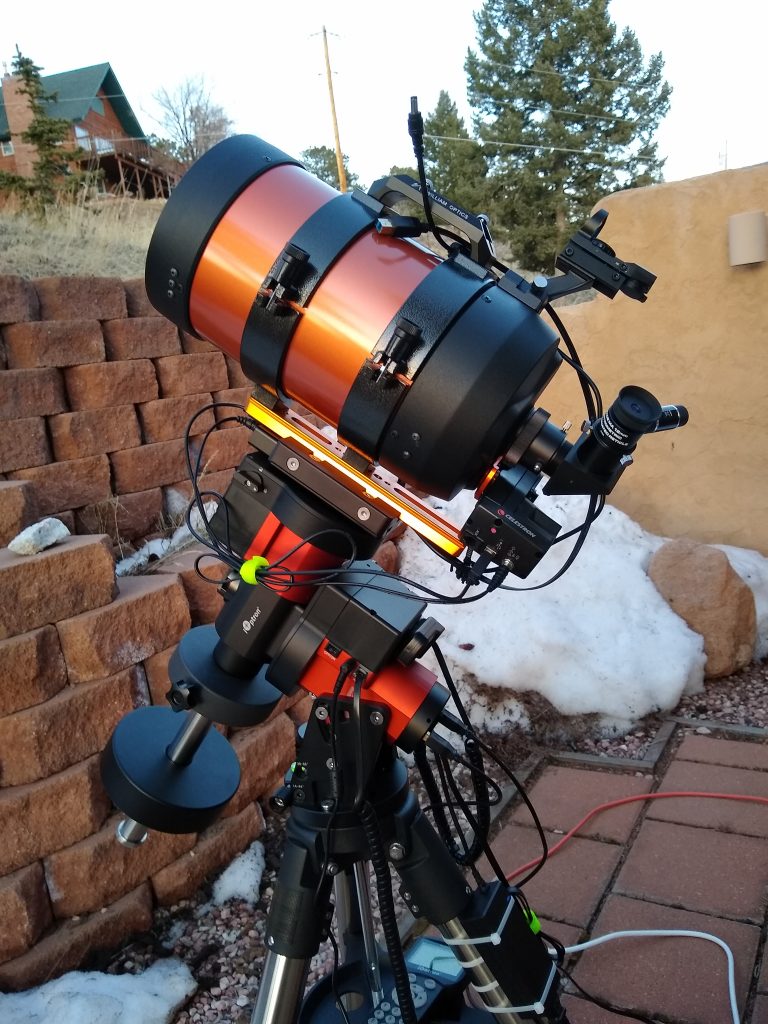
I’ve been thoroughly enjoying my time taking astrophotographs using my Sky-Watcher Esprit 100 f/5.5 apo refractor, ZWO ASI533MC Pro camera, and iOptron GEM45 mount over the past several months. The Sky-Watcher has been a joy to use, yielding sharp views in a field of view that works well for nebula and other larger targets. But with the onset of spring, most of the best targets in the night sky are galaxies–spectacular, but smaller. So I decided it was time to give my Celestron NexStar 6SE a try. Not the mount, mind you–it’s an alt-az mount with a lot of backlash in the motor drives–just the optical tube assembly (OTA). The C6 is a 150-mm f/10 with decent optics. A 1500-mm focal length seemed like quite a challenge for imaging, though, so I added the Celestron 0.63x focal reducer to the mix.
I didn’t really know how well this was going to work. I was pretty sure that the C6 could do a decent job imaging, but the 0.63x reducer was an unknown in terms of optical quality as well as the required back focus (the optimal distance from the back of the reducer to the camera sensor). I spent quite a bit of time searching for information about the best back focus for the reducer and came up with a modest consensus that 105 mm was a good number.
Another complication in using the C6 OTA was mounting it on the GEM45 mount. The OTA from the NexStar 6SE has a Vixen-style dovetail screwed to the side of the tube, and while the GEM45 mount will accept a Vixen dovetail, that particular configuration made it difficult to get the tube in the right position on the saddle for balancing purposes. Ultimately, I decided to replace that dovetail with a William Optics 245 mm long dovetail bar and a pair of tube rings. Now I can adjust the position of the tube in the tube rings, and I can adjust the position of the tube rings on the bar in order to make balancing easier (with or without the camera on the back end). It also made it easier to set the tube ring spacing so I could mount the William Optics 120 mm Handle Bar to the top, to hold my guide scope.


The final piece to the puzzle was to add the Celestron focus motor. Stepper-motor-driven focusers make focusing for imaging so much easier, because most imaging software (I use N.I.N.A) can control the focuser and find optimal focus for you, greatly simplifying the imaging process and improving overall image focus. I personally have found the ability to autofocus to be a godsend.
Given all that, I was able to collect the data for the image of M81 you see at the top of this post. For this image I collected about 12 hours worth of 3-minute subs and then kept the top 50% of them (according to Deep Sky Stacker, anyway). The image was taken through a UV/IR filter. The final image was stacked using dark, flat, dark flat, and bias calibration frames, and then processed using Affinity Photo. I also used AstroFlat Pro and Denoise AI as part of the processing. I also used Affinity Photo macros from James Ritson, which greatly streamlined processing.
I’m hoping to add some more data to this image yet–perhaps some narrowband stuff shot through my L-Extreme filter. It appears, too, that the C6 OTA could stand a check of collimation, so I’m going to be exploring that as well. My attempt at collimating the C6 under the stars was a miserable failure, so I’m purchasing a collimation eyepiece and trying some techniques for collimating in daylight on the test bench. Wish me luck.

Great write up and super nice rig. I also have the C6 and am just now venturing into the depths of astrophotography. Hope my 15 year old original Canon EOS D5 has a few more miles in it.
Great post! I got your mentioned rings and dovetail — have they been sturdy for you? I’m admittedly nervous about them popping under strain and I lose an $800 OTA! Is this irrational fear? Never used rings before. Thanks!
I found the dovetail and rings to be very secure. No worries there.
Dave
hey dave,
have you been able to take any images using the C6?
A few. The stock Celestron reducer really isn’t up to the task. I have the Starizona reducer now that I plan to use with a C8 that I acquired. I also have an off axis guider that will help with tracking, I believe.
Hello, did you have any problem when you removed the stock dovetail of the 6SE OTA ?
No, it was pretty easy. Just two or three screws to remove, if I recall correctly.
Dave, I’m having real problems with my C6. I totally agree with you, the Celestron .63X corrector is not good. But even bigger than the issue with coma, I have MAJOR tilt of the camera axis according to every test frame I have shot with ASTAP. No bueno. Despite spending hours on a very precise collimation and guiding on an AM5 mount from ZWO, my stars have a terrible shape. I wish you much better fortune. Bob
Bob, I’ve seen indications of camera tilt, although I haven’t yet pursued it. I was going to blame it on collimation but haven’t yet had a chance to check it. I was disappointed, though, to determine that off-axis guiding on the NexStar 6SE OTA is really a no-go due to the fact that the rear opening is only 1.25″. I tried off-axis guiding with the 6SE and had no luck (and yes, I’ve been able to use the same OAG successfully with my C8 as well as a couple refractors). I did manage to eke out an image of Thor’s Helmet (I posted that one recently) but because of poor guiding it required a lot of processing help. I’m going to give it another try yet this spring if I get the chance, but I doubt I’ll continue imaging with the 6SE after that.
Hi Dave, Bob, I came across your post by accident while looking for whether different year built C6 and 6SE’s had twist-locking dust caps (I bought mine in 2019, and it did not). The image of your scope caught my attention as I’m also running a guided 6SE, albeit on an equatorial wedge.
I’ve spent god knows how long trying to collimate my scope and came away with a couple of interesting points:
– with the f6.3 reducer/corrector, there will still be some visible stretching around the corners (I’m using an ASI294MC Pro), but you can minimize it
– DO NOT over-crank the collimation screws on the secondary mirror. You think you’re tightening them so they stay in place, but what you’re actually doing is pushing the mirror forward, changing the distance between it and the primary mirror. This will make the star distortions much worse around the edges. Use a light touch to secure the collimation screws.
– what looks like sensor tilt (or other tilt in the optics) might actually be collimation in that the corner that is too far will have stars with the tell-tale ” ) ” curvature, but the opposite corner will have a sometimes imperceptible ‘ > ‘ shape. I like the old OPT page for back-focus as it applies to collimation except you’re comparing corner to corner:
https://optcorp.com/blogs/deep-sky-imaging/how-to-set-the-correct-back-focus
– loosen the secondary mirror cap and turn the mirror so that you have two screws along the top and one at the bottom, making a ‘V’. This will make adjustments easier because the screws will directly affect the top corners of your image.
– if you’re still looking for indoor collimation tools, try using pixels on your laptop as stars. I’ve had a lot of luck with this along with ASTAP, which I already had as that’s what APT uses for plate solving. ASTAP has a built-in function for image analysis which shows your how much deflection you have across your field of view. I went so far as to make a video about it:
https://youtu.be/weaREykf8iM
– The tightening ring on the 2″ 93633-A T-Adapter (which Dave has connected to the focal reducer in the top image) allows for some play in the position of the tube, try to center the tube as you tighten the ring so that it is not off to one side.
Clear Skies!
Bob, thanks for all the great information!